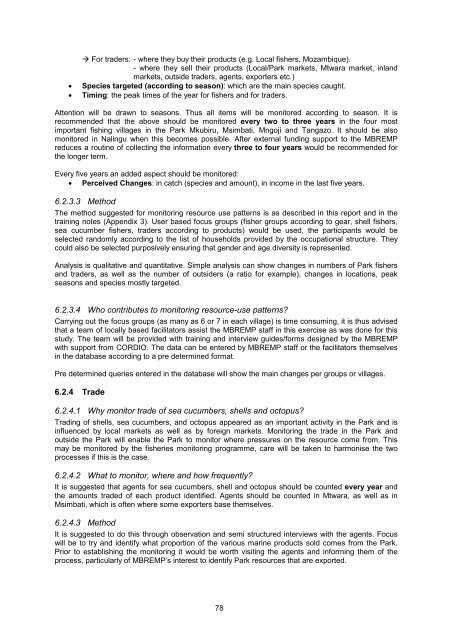a socio-economic baseline assessment of the mnazi bay - IUCN
a socio-economic baseline assessment of the mnazi bay - IUCN
a socio-economic baseline assessment of the mnazi bay - IUCN
Create successful ePaper yourself
Turn your PDF publications into a flip-book with our unique Google optimized e-Paper software.
For traders: - where <strong>the</strong>y buy <strong>the</strong>ir products (e.g. Local fishers, Mozambique).<br />
- where <strong>the</strong>y sell <strong>the</strong>ir products (Local/Park markets, Mtwara market, inland<br />
markets, outside traders, agents, exporters etc.)<br />
• Species targeted (according to season): which are <strong>the</strong> main species caught.<br />
• Timing: <strong>the</strong> peak times <strong>of</strong> <strong>the</strong> year for fishers and for traders.<br />
Attention will be drawn to seasons. Thus all items will be monitored according to season. It is<br />
recommended that <strong>the</strong> above should be monitored every two to three years in <strong>the</strong> four most<br />
important fishing villages in <strong>the</strong> Park Mkubiru, Msimbati, Mngoji and Tangazo. It should be also<br />
monitored in Nalingu when this becomes possible. After external funding support to <strong>the</strong> MBREMP<br />
reduces a routine <strong>of</strong> collecting <strong>the</strong> information every three to four years would be recommended for<br />
<strong>the</strong> longer term.<br />
Every five years an added aspect should be monitored:<br />
• Perceived Changes: in catch (species and amount), in income in <strong>the</strong> last five years.<br />
6.2.3.3 Method<br />
The method suggested for monitoring resource use patterns is as described in this report and in <strong>the</strong><br />
training notes (Appendix 3). User based focus groups (fisher groups according to gear, shell fishers,<br />
sea cucumber fishers, traders according to products) would be used, <strong>the</strong> participants would be<br />
selected randomly according to <strong>the</strong> list <strong>of</strong> households provided by <strong>the</strong> occupational structure. They<br />
could also be selected purposively ensuring that gender and age diversity is represented.<br />
Analysis is qualitative and quantitative. Simple analysis can show changes in numbers <strong>of</strong> Park fishers<br />
and traders, as well as <strong>the</strong> number <strong>of</strong> outsiders (a ratio for example), changes in locations, peak<br />
seasons and species mostly targeted.<br />
6.2.3.4 Who contributes to monitoring resource-use patterns?<br />
Carrying out <strong>the</strong> focus groups (as many as 6 or 7 in each village) is time consuming, it is thus advised<br />
that a team <strong>of</strong> locally based facilitators assist <strong>the</strong> MBREMP staff in this exercise as was done for this<br />
study. The team will be provided with training and interview guides/forms designed by <strong>the</strong> MBREMP<br />
with support from CORDIO. The data can be entered by MBREMP staff or <strong>the</strong> facilitators <strong>the</strong>mselves<br />
in <strong>the</strong> database according to a pre determined format.<br />
Pre determined queries entered in <strong>the</strong> database will show <strong>the</strong> main changes per groups or villages.<br />
6.2.4 Trade<br />
6.2.4.1 Why monitor trade <strong>of</strong> sea cucumbers, shells and octopus?<br />
Trading <strong>of</strong> shells, sea cucumbers, and octopus appeared as an important activity in <strong>the</strong> Park and is<br />
influenced by local markets as well as by foreign markets. Monitoring <strong>the</strong> trade in <strong>the</strong> Park and<br />
outside <strong>the</strong> Park will enable <strong>the</strong> Park to monitor where pressures on <strong>the</strong> resource come from. This<br />
may be monitored by <strong>the</strong> fisheries monitoring programme, care will be taken to harmonise <strong>the</strong> two<br />
processes if this is <strong>the</strong> case.<br />
6.2.4.2 What to monitor, where and how frequently?<br />
It is suggested that agents for sea cucumbers, shell and octopus should be counted every year and<br />
<strong>the</strong> amounts traded <strong>of</strong> each product identified. Agents should be counted in Mtwara, as well as in<br />
Msimbati, which is <strong>of</strong>ten where some exporters base <strong>the</strong>mselves.<br />
6.2.4.3 Method<br />
It is suggested to do this through observation and semi structured interviews with <strong>the</strong> agents. Focus<br />
will be to try and identify what proportion <strong>of</strong> <strong>the</strong> various marine products sold comes from <strong>the</strong> Park.<br />
Prior to establishing <strong>the</strong> monitoring it would be worth visiting <strong>the</strong> agents and informing <strong>the</strong>m <strong>of</strong> <strong>the</strong><br />
process, particularly <strong>of</strong> MBREMP’s interest to identify Park resources that are exported.<br />
78
















